Audio
THR History and Development
The hip is replaced because of the symptoms a person experiences, not just because they have any particular condition. There are three main symptoms that would suggest a hip replacement should be carried out:
Pain
This is the overriding reason for performing a hip replacement. The commonest cause of pain in the hip is osteoarthritis, often referred to as degenerative disease, or osteoarthrosis. It is important that both surgeon and patient consider preoperatively whether the pain level is sufficient to justify undertaking such a major procedure. If replacement is performed when pain levels are not high, the result can be disappointing for the patient. However, if a patient has had unremitting, deep-seated pain for many months or years, the effect of a total hip replacement can be dramatic.
Deformity
As a result of contracture formation, or perhaps because of previous disease, the hip can become very deformed. This can make walking impossible and hip replacement may be offered as treatment in such cases.
Patients with deformed joints usually also experience pain and it is the presence of the pain in addition to the deformity that justifies the total hip replacement. An operation performed for deformity alone can be successful in terms of range of movement and function, but may leave a disappointed patient. The operation does not provide a true replacement hip but an artificial one. To expect an artificial hip to behave exactly like a normal one is unrealistic. This sometimes happens, but not always.
The Other Joints Need To Be Protected
When hip disease is advanced, it is possible for the joint to become so destroyed that pain diminishes. As destruction progresses, so the range of movement decreases and so the strains normally borne by the hip are taken up by the joints surrounding it - in particular, the knee and the spine. It is occasionally necessary to perform a hip replacement in order to protect these adjacent joints from further damage.
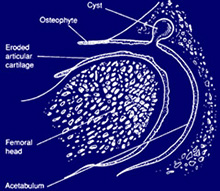 |
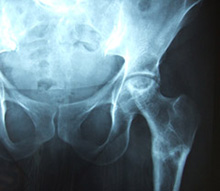 |
Diagrammatic representation of osteoarthritis of the hip joint. The articular cartilage (gristle) becomes eroded, exposing underlying bone. Soon the bone becomes hardened (eburnated) and increasingly painful. Cysts appear deep inside the bone and osteophytes develop - protrusions from the margins of a joint that can restrict movement. |
Avascular necrosis of the left hip. This condition is caused by damaged blood supply to the ball of the hip joint (femoral head) and sometimes leads to a hip replacement being needed in younger patients. |
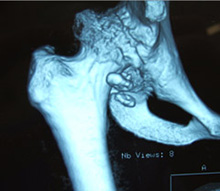 |
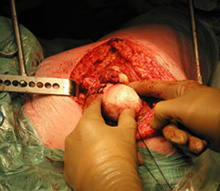 |
Three-dimensional CT scan of gross osteoarthritis of the right hip in a young patient. The deformity of the femoral head is clear to see. Total hip replacement was needed, with an excellent result. |
Operative photograph of an osteoarthritic hip. The erosion and irregularity of the femoral head is clear to see. |
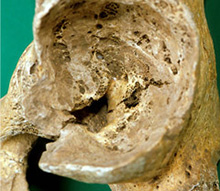 |
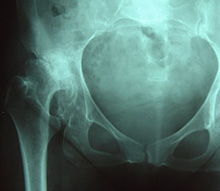 |
Osteoarthritis of the hip is not new! This photograph is of an Anglo-Saxon hip socket, which demonstrates severe osteoarthritis. Oh if that hip replacement had been available then! |
This patient’s right hip shows severe osteoarthritis in an abnormally developed hip joint. Sometimes, failure of development of a hip joint (so-called dysplasia) can predispose a patient to developing osteoarthritis and can also lead to quite a complex total hip replacement being needed. |
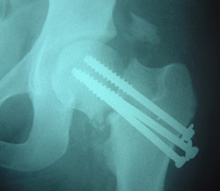 |
|
A broken hip which has failed to heal despite three screws being inserted. This may be an indication to remove the screws and insert a total hip replacement. |
|
